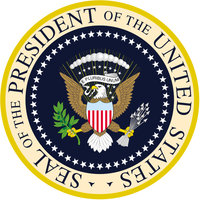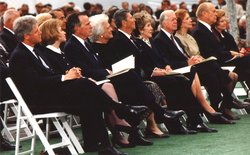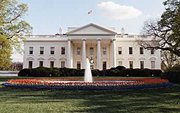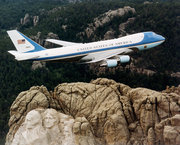President of the United States
|
|
The President of the United States is the head of state of the United States. Under the U.S. Constitution, the President is also the chief executive of the federal government and commander-in-chief of the armed forces.
Because of the superpower status of the United States, the American President is considered by many to be the most powerful person on Earth, and is usually one of the world's best-known public figures. During the Cold War, the President was sometimes referred to as "the leader of the free world," a phrase that is still invoked today, mostly by Americans.
The United States was the first nation to create the office of President, the head of government in a republic. Today the office is widely emulated all over the world in nations with a presidential system of government.
The current President of the United States is George W. Bush.
| Contents |
Requirements to hold office
Section One of Article II of the U.S. Constitution establishes the requirements one must meet in order to become President. The president must be a natural-born citizen of the United States (or a citizen of the United States at the time the U.S. Constitution was adopted), be at least 35 years of age, and have been a resident of the United States for 14 years.
The natural-born citizenship requirement has been the subject of some controversy in recent years. Some commentators argue that the clause should be repealed because it excludes qualified people based on technicalities, and fails to appreciate the contributions made by immigrants to American society. Prominent public officials that are barred from the presidency because they were not born U.S. citizens include California Gov. Arnold Schwarzenegger, born in Austria; Florida Sen. Mel Martinez and Secretary of Commerce Carlos Gutierrez, both born in Cuba; Secretary of Labor Elaine Chao, born in Taiwan; Director of National Intelligence John Negroponte, born in the United Kingdom; former Secretary of State Madeleine Albright, born in Czechoslovakia; and Michigan Gov. Jennifer Granholm, born in British Columbia, Canada. Occasionally, constitutional amendments are proposed to remove or amend this requirement, but none have yet been successful.
Under the Constitution, the President serves a four-year term. Amendment XXII (which took effect in 1951 and was first applied to Dwight D. Eisenhower starting in 1953) limits the president to either two four-year terms or a maximum of ten years in office should he have succeeded to the Presidency previously and served less than two years completing his predecessor's term. Since then, three presidents have served two full terms: Dwight Eisenhower, Ronald Reagan, and Bill Clinton. Incumbent President George W. Bush will become the fourth at the completion of his current term in 2008.
Presidential elections
U.S. presidential elections are held every four years. Presidents are elected indirectly, through the Electoral College. The President and the Vice President are the only two nationally elected officials in the United States. (Legislators are elected on a state-by-state basis; other executive officers and judges are appointed.) Originally, each elector voted for two people for President. The votes were tallied and the person receiving the greatest number of votes (provided that such a number was a majority of electors) became President, while the individual who was in second place became Vice President.
The ratification of Amendment XII in 1804 changed the electoral process by directing the electors to use separate ballots to vote for the President and Vice President. To be elected, a candidate must receive a majority of electoral votes, or if no candidate receives a majority, the President and Vice President are chosen by the House of Representatives and Senate, respectively, as necessary. Since 1933, with the ratification of Amendment XX, a newly-elected President, or a re-elected incumbent, is sworn into office on January 20 of the year following the election, an event called Inauguration Day. Although the Chief Justice of the United States usually administers the presidential oath of office, any federal judge can administer the oath — and even judges of federal district courts have fulfilled this duty in emergencies. See Sarah T. Hughes.
On Inauguration Day, following the oath of office, the President customarily delivers an inaugural address which sets the tone for his administration.
The modern Presidential election process begins with the primary elections, during which the major parties (currently the Democrats and the Republicans) each select a nominee to unite behind; the nominee in turn selects a running mate to join him on the ticket as the Vice Presidential candidate. The two major candidates then face off in the general election, usually participating in nationally televised debates before Election Day and campaigning across the country to explain their views and plans to the voters. Much of the modern electoral process is concerned with winning swing states, through frequent visits and mass media advertising drives.
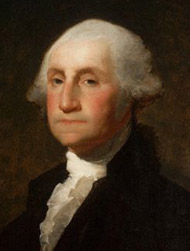
In accordance with Article II, Section 1, Paragraph 8 of the Constitution, upon entering office, the President must take the following oath or affirmation: "I do solemnly swear (or affirm) that I will faithfully execute the Office of President of the United States, and will to the best of my Ability, preserve, protect, and defend the Constitution of the United States." Only presidents Franklin Pierce and Herbert Hoover have chosen to affirm rather than swear. The oath is traditionally ended with, "So help me God," although for religious reasons some Presidents have said, "So help me."
Presidential powers
Main article: Powers of the President of the United States
The office of president of the United States is one of the most powerful offices of its kind in the world. The president, the Constitution says, must "take care that the laws be faithfully executed." To carry out this responsibility, the president presides over the executive branch of the federal government — a vast organization numbering about 4 million people, including 1 million active-duty military personnel. In addition, the president has important legislative and judicial powers.
Succession
The United States presidential line of succession is a detailed list of government officials to serve or act as President upon a vacancy in the office due to death, resignation, or removal from office (by impeachment and conviction). The line of 17 begins with the Vice President and ends with the Secretary of Veterans Affairs.
The Constitution provided that, if a President were to die, resign, or be removed from office, the "powers and duties" of the office would devolve upon the Vice President, but did not specify whether the Vice President would succeed to the office of President or merely act as President. After the death of William Henry Harrison, however, Vice President John Tyler asserted that he had become the President, not merely Acting President, and this precedent was followed in all subsequent cases.
The 25th amendment eliminated this ambiguity by confirming the Vice President as first in the order as well as spelling out a process for him to serve as Acting President should the President become disabled. A provision of the United States Code (Template:UnitedStatesCode) establishes the rest of the succession line.
To date no officer other than the Vice President has been called upon to act as President.
Office-holders
For a list of persons who served as the President of the United States following the ratification of the United States Constitution see the list of Presidents of the United States. (For leaders prior to this ratification, see President of the Continental Congress.)
Timeline
- Martin Van Buren, born December 5, 1782, was the first president born after the Declaration of Independence and was thus arguably the first president who was not born a British subject. Interestingly, he is also the first president not of British descent.
- John Tyler, born March 29, 1790, was the first president born after the adoption of the U.S. Constitution, all presidents born before him were eligible to be president because they were citizens at the time the Constitution was adopted, not because they were natural born citizens. (Zachary Taylor was born on November 24, 1784, before the Constitution was adopted).
- Franklin Pierce, born November 23, 1804, was the first president born in the 19th century. Millard Fillmore was born January 7 1800; however, 1801 marked the first year of the 19th century, not 1800.
- Warren Harding, born November 2 1865, was the first president born after the American Civil War. Lee surrendered 9 April 1865.
- John F. Kennedy, born May 29, 1917, was the first president born in the 20th century.
- Jimmy Carter, born October 1 1924, was the first president born after World War I.
- George H. W. Bush, who succeeded Carter's successor, was born on June 12, 1924.
- Bill Clinton, born August 19 1946, was the first president born after World War II.
- Clinton's successor, George W. Bush, was born July 6 1946.
Former Presidents
After a president of the U.S. leaves office, the title "President" continues to be applied to that person the rest of his life. Former presidents continue to be important national figures, and in some cases go on to successful post-presidential careers. Notable examples have included William Howard Taft's tenure as Chief Justice of the United States and Jimmy Carter's current career as a global human rights campaigner and best-selling writer. Andrew Johnson was elected to the same Senate that tried his impeachment after his term was over.
As of May 2005, there are four living former presidents: Gerald Ford, Jimmy Carter, George H. W. Bush and Bill Clinton. The most recently deceased President is Ronald Reagan, who died in June 2004.
There have never been more than five former presidents alive at any given time in American history. There have been three periods during which five former presidents were alive:
- From March 4, 1861, to January 18, 1862, Martin Van Buren, John Tyler, Millard Fillmore, Franklin Pierce, and James Buchanan were living (during the Lincoln Administration, until the death of Tyler).
- From January 20, 1993, to April 22, 1994, Richard Nixon, Gerald Ford, Jimmy Carter, Ronald Reagan, and George H. W. Bush were living (during the Clinton Administration, until the death of Nixon).
- From January 20, 2001, to June 5, 2004, Gerald Ford, Jimmy Carter, Ronald Reagan, George H. W. Bush, and Bill Clinton were living (during the George W. Bush Administration, until the death of Reagan).
There have been six periods in American history during which no former presidents were alive:
- April 30, 1789 - March 4, 1797: The trivial case of George Washington, the first president.
- December 14, 1799 - March 4, 1801: from the death of former President George Washington until incumbent President John Adams left office (no former president would die until Adams and his successor, Thomas Jefferson, both did so on July 4 1826).
- July 31, 1875 - March 4, 1877: from the death of former President Andrew Johnson until incumbent President Ulysses Grant left office (no former president would die until Grant did so in 1885 although incumbent President James Garfield was assassinated in 1881).
- June 24, 1908 - March 4, 1909: from the death of former President Grover Cleveland until incumbent President Theodore Roosevelt left office (no former president would die until Roosevelt did so in 1919).
- January 5, 1933 - March 4, 1933: from the death of former President Calvin Coolidge until incumbent President Herbert Hoover left office (no former president would die until Hoover did so in 1964 although incumbent President Franklin Roosevelt died in office in 1945 and incumbent President John Kennedy was assassinated in 1963).
- January 22, 1973 - August 9, 1974: from the death of former President Lyndon Johnson until incumbent President Richard Nixon resigned (no former president would die until Nixon did so in 1994).
Herbert Hoover had the longest post-presidency, 31 years. He left office in 1933 and died in 1964. James K. Polk had the shortest post-presidency. He died on June 15, 1849, a mere three months after the expiration of his term.
Franklin D. Roosevelt is the only President to serve more than 8 years in the office (1933-1945). Prior to his administration, presidents chose to follow the example set by George Washington to limit their tenure to two terms or less. Following the passage of the Twenty-second Amendment in 1951, however, a two-term limit became the law.
Between the birth of George Washington in 1732 and the birth of Bill Clinton in 1946, future presidents have been born in every decade except two: the 1810s and the 1930s. Between the death of George Washington in 1799 and the present, presidents or ex-presidents have died in every decade except four: the 1800s, 1810s, 1950s, and 1980s.
Presidential salary and benefits
| Date established | Salary |
|---|---|
| September 24, 1789 | $25,000 |
| March 3, 1873 | $50,000 |
| March 4, 1909 | $75,000 |
| January 19, 1949 | $100,000 |
| January 20, 1969 | $200,000 |
| January 20, 2001 | $400,000 |
The First U.S. Congress voted to pay George Washington a salary of $25,000 a year — a significant sum in 1789. Washington, already a successful man, refused to accept his salary. Since 2001, the President has earned a salary of $400,000 a year.
Traditionally, the President, as the most important official in the U.S. government, is the highest-paid government employee. Consequently, the President's salary serves as a cap of sorts for all other federal officials, such as the Chief Justice. The raise for 2001 was approved by Congress and President Bill Clinton in 1999 because other officials who receive annual cost-of-living increases had salaries approaching the President's. Consequently, in order to raise the salaries of the other federal employees, the President's salary had to be raised as well.
Modern Presidents enjoy many non-salary benefits such as living and working in the spacious White House mansion in Washington, DC. While traveling, the President is able to conduct all the functions of the office aboard several specially-built Boeing 747s, which take the call sign Air Force One when the President is aboard. The President travels around Washington in an armored Cadillac limousine, equipped with bullet-proof windows and tires and a self-contained ventilation system in the event of a biological or chemical attack. When traveling longer distances around the Washington area or on presidential trips, the President travels aboard the presidential helicopter, which takes the call sign Marine One when the president is aboard. Additionally, the President has full use of Camp David in Maryland, a sprawling retreat occasionally used as a casual setting for hosting foreign dignitaries.
The President and his family are protected at all times by an extensive Secret Service detail. Until 1997, all former Presidents and their families were protected by the Secret Service until the President's death. The last President to have lifetime Secret Service protection is Bill Clinton; George W. Bush and all subsequent Presidents will be protected by the Secret Service for a maximum of 10 years after leaving office.
Presidents continue to enjoy other benefits after leaving office such as free mailing privileges, free office space, the right to hold a diplomatic passport and budgets for office help and staff assistance. However, it was not until after Harry S. Truman (1958) that Presidents received a pension after they left office. Additionally, since the presidency of Herbert Hoover, Presidents receive funding from the National Archives and Records Administration upon leaving office to establish their own presidential library. These are not traditional libraries, but rather repositories for preserving and making available the papers, records, and other historical materials for each President since Herbert Hoover.
The President has the use of:
Presidential residences
The President's principal workplace and official residence is the White House at 1600 Pennsylvania Avenue, NW in Washington, DC. His official vacation or weekend residence is Camp David in Maryland. Many Presidents have also had their own homes.
Presidential facts
Transition events
- Four U.S. Presidents have been assassinated while in office:
- Abraham Lincoln in 1865 by John Wilkes Booth
- James Garfield in 1881 by Charles J. Guiteau (Guiteau shot him but Garfield arguably died due to subsequent incorrect medical care)
- William McKinley in 1901 by Leon Czolgosz
- John F. Kennedy in 1963 by Lee Harvey Oswald [1] (http://www.archives.gov/research_room/jfk/warren_commission/warren_commission_report_chapter1.html) although many theories suggest additional gunmen. [2] (http://www.archives.gov/research_room/jfk/house_select_committee/committee_report_gunmen.html)
- Four others died in office of natural causes:
- William Henry Harrison, died of pneumonia in 1841
- Zachary Taylor, died of "acute indigestion" in 1850
- Warren G. Harding, died of heart attack in 1923
- Franklin D. Roosevelt, died of cerebral hemorrhage in 1945
- One President resigned from office:
- Two Presidents have been impeached, though neither was subsequently convicted:
- Andrew Johnson in 1868
- Bill Clinton in 1999
- Four Presidents have been elected without a plurality of popular votes:
- John Quincy Adams - trailed Andrew Jackson by 44,804 votes in the 1824 election
- However, in six of the then twenty-four states in 1824, the electors were chosen by the state legislature, with no popular vote.
- Rutherford B. Hayes - trailed Samuel J. Tilden by 264,292 votes in the 1876 election
- Benjamin Harrison - trailed Grover Cleveland 95,713 votes in the 1888 election
- George W. Bush - trailed Al Gore by 540,520 votes in the 2000 election
- John Quincy Adams - trailed Andrew Jackson by 44,804 votes in the 1824 election
- Eleven Presidents have been elected fourteen times without a majority of popular votes (but with a plurality of popular votes):
- James K. Polk - 49.3% of the popular vote in the 1844 election
- Zachary Taylor - 47.3% of the popular vote in the 1848 election
- James Buchanan - 45.3% of the popular vote in the 1856 election
- Abraham Lincoln - 39.9% of the popular vote in the 1860 election
- James A. Garfield - 48.3% of the popular vote in the 1880 election
- Grover Cleveland - 48.8% of the popular vote in the 1884 election
- Grover Cleveland - 46.0% of the popular vote in the 1892 election
- Woodrow Wilson - 41.8% of the popular vote in the 1912 election
- Woodrow Wilson - 49.3% of the popular vote in the 1916 election
- Harry S. Truman - 49.7% of the popular vote in the 1948 election
- John F. Kennedy - 49.7% of the popular vote in the 1960 election
- Richard Nixon - 43.2% of the popular vote in the 1968 election
- Bill Clinton - 42.9% of the popular vote in the 1992 election
- Bill Clinton - 49.2% of the popular vote in the 1996 election
- Two Presidents have been elected without a majority of electoral votes, and were chosen by the House of Representatives:
- Thomas Jefferson - finished with same number of electoral votes as Aaron Burr in the 1800 election
- John Quincy Adams - trailed Andrew Jackson by 15 electoral votes in the 1824 election
- Eight Presidents took office without being elected to the Presidency, having been elected as Vice Presidents and then promoted from that position:
- Four of them did not run to succeed themselves, and were never elected president.
- John Tyler - Assumed the Presidency on the death of William Henry Harrison, did not run in the 1844 election
- Millard Fillmore - Succeeded Zachary Taylor, did not run in the 1852 election
- Andrew Johnson - Succeeded Abraham Lincoln, did not run in the 1868 election
- Chester A. Arthur - Succeeded James Garfield, did not run in the 1884 election
- The other four later ran for president, and were elected to succeed themselves as president:
- Theodore Roosevelt - Succeeded William McKinley, elected to succeed himself as president in the 1904 election
- Calvin Coolidge - Succeeded Warren G. Harding, elected to succeed himself as president in the 1924 election
- Harry S. Truman - Succeeded Franklin D. Roosevelt, elected to succeed himself as president in the 1948 election, but did not run again in the 1952 election, despite being eligible for a third term.
- Lyndon B. Johnson - Succeeded John F. Kennedy, elected to succeed himself as president in the 1964 election, but did not run again in the 1968 election
- Four of them did not run to succeed themselves, and were never elected president.
- One President, Gerald Ford, was never elected but was appointed Vice President by Richard Nixon (with approval from Congress) upon the resignation of Vice President Spiro Agnew, succeeded to the Presidency after Nixon's resignation, and was defeated in the 1976 election by Jimmy Carter. He remains the only President neither elected as President nor as Vice President.
- Four Presidents had never held any prior elected office:
- An urban legend claims that David Rice Atchison was the 11 1/2 president of the United States for one day on March 4, 1849 in between the terms of James K. Polk (whose term expired at noon on 4 March) and Zachary Taylor (who chose not to be sworn in until 5 March). However, the logic of this is contradictory. If one does not consider Taylor to have officially become President until the administration of his Oath of Office, then the same logic precludes any person from having automatically succeeded before likewise having taken the same Oath. In fact, Taylor, as President-elect, automatically acceded to the Office of President upon the expiration of Polk's term, even if he did not yet enter into the execution of that Office until the Oath was administered. This fact was confirmed by Congress when it certified his election, as it defined the beginning of the administration as the instant Polk left office. Even if supposing, for the sake of argument, the rather odd interpretation that only Presidents-elect are required to take the Oath before officially occupying the Office, whilst officials in the Presidential Line of Succession occupy the Presidency ipso facto, then there would be a long list of dozens of additional "Presidents" who only held the office for a matter of hours or minutes.
- Stephen Grover Cleveland had two non-consecutive terms as President, and is counted both as the 22nd and the 24th President, as can be confirmed from the list above. Consequently, all subsequent Presidents who are referred to as "the <n>th President of the United States" are actually the <n-1>th person to hold the office. E.g., George W. Bush, 43rd President, is actually the 42nd person to be President.
Other facts
While most presidents have been of substantially English descent, there have been a few who came from a different background:
- Predominantly Dutch: Martin Van Buren
- Although Theodore Roosevelt and Franklin D. Roosevelt had Dutch names, neither was predominantly Dutch; each had only one Dutch grandfather. Theodore's other three grandparents were all North British; Franklin's other three grandparents were of Puritan stock.
- Predominantly German: Herbert Hoover and Dwight Eisenhower
- Predominantly Irish: Andrew Jackson, William McKinley, John F. Kennedy, Richard Nixon, Ronald Reagan, Bill Clinton
- Kennedy was also America's only Roman Catholic president.
- No women nor non-white males have yet served as President of the United States.
- Only one president, James Buchanan, remained a bachelor.
- A 1999 survey of academic historians by CSPAN found that historians consider Abraham Lincoln, George Washington, and Franklin D. Roosevelt the three best presidents by a wide margin and William Henry Harrison, Andrew Johnson, Franklin Pierce and James Buchanan the worst [3] (http://www.americanpresidents.org/survey/historians/performance.asp). A 2000 survey by The Washington Post deemed George Washington, Abraham Lincoln, and Franklin Roosevelt to be the only "great" Presidents while Andrew Johnson, Franklin Pierce, Warren G. Harding, and James Buchanan were regarded the only "failures" [4] (http://www.opinionjournal.com/hail/rankings.html).
- The Secret Service and some agencies in the government use acronyms as jargon. Since the Truman Administration the President of the United States has been called POTUS, pronounced "poh-tuss". The wife of the President, traditionally referred to as the First Lady is called FLOTUS, pronounced "flo-tuss". The Vice President of the United States is often abbreviated to VPOTUS, pronounced "vee-poh-tuss".
- The President is known to be able to affect trends in popular culture. An endorsement of a book or a movie by a president can easily launch the career of a author or a filmmaker. For example, Ronald Reagan's admiration of The Hunt For Red October caused Tom Clancy to become a nationally acclaimed bestselling author, something that may never have happened had it not been for Reagan's endorsement.
Image Resources
Presidential trivia lists
Presidential candidate trivia lists
- List of major party U.S. presidental candidates who lost their home state
- List of unsuccessful major-party U.S. presidential candidates military service
- List of unsuccessful U.S. Presidential assassination attempts
- List of unsuccessful U.S. Presidential candidates who received at least one electoral vote
Related topics
- President of the Continental Congress
- Presidential reputation
- Presidential Service Badge
- Executive branch
- Executive privilege
- Air Force One
- Tecumseh's curse
- List of fictional U.S. Presidents
- List of fictional U.S. Vice Presidents
- List of fictional U.S. Presidential candidates
- Fiction regarding United States presidential succession
- List of actors who played President of the United States
Past and future Presidential elections
Template:Uspresidentialelections
Lesson Plans and Activities
History Clipart and Pictures
- Pictures of the US Presidents (http://classroomclipart.com/cgi-bin/kids/imageFolio.cgi?direct=History/United_States/Presidents)
- Clipart of American Presidents (http://classroomclipart.com/cgi-bin/kids/imageFolio.cgi?direct=Clipart/American_Presidents)
- Historical Pictures of the United States (http://classroomclipart.com/cgi-bin/kids/imageFolio.cgi?direct=History/United_States)
- Pictures of the American Revolution (http://classroomclipart.com/cgi-bin/kids/imageFolio.cgi?direct=History/United_States/American_Revolution)
- Civil Rights Pictures (http://classroomclipart.com/cgi-bin/kids/imageFolio.cgi?direct=History/United_States/Civil_Rights)
- Civil War Images (http://classroomclipart.com/cgi-bin/kids/imageFolio.cgi?direct=History/United_States/Civil_War)
- Pictures of Colonial America (http://classroomclipart.com/cgi-bin/kids/imageFolio.cgi?direct=History/United_States/Colonial_America)
- Historical US Illustrations (http://classroomclipart.com/cgi-bin/kids/imageFolio.cgi?direct=History/United_States/Illustrations)
- World War II Pictures (http://classroomclipart.com/cgi-bin/kids/imageFolio.cgi?direct=History/United_States/World_War_II)
- Pictures of Historical People (http://classroomclipart.com/cgi-bin/kids/imageFolio.cgi?direct=History/United_States/People)
External links
- The maps by counties of the presidential elections since 1856 (http://geoelections.free.fr)
- Official White House website (http://www.whitehouse.gov/)
- The American Presidency Project (UC Santa Barbara: 52,000+ Presidential Documents) (http://www.presidency.ucsb.edu/)
- Internet Public Library: POTUS (http://www.ipl.org/div/potus/)
- Genealogies of the Presidents (http://www.blue-blood.co.uk)
- Inaugural Addresses of the Presidents of the United States (http://www.usa-presidents.info/inaugural/)
- Presidential Speeches Archive (http://www.geocities.com/americanpresidencynet/archive.htm)
- The Masonic Presidents Tour (http://www.pagrandlodge.org/mlam/presidents/index.html)
- The American Presidency - Selected Resources, an informal reference guide (http://www.geocities.com/americanpresidencynet/)
- C-SPAN: Life Portraits of the American Presidents (http://www.americanpresidents.org/)
- Teaching about the U.S. Presidency (http://ericdigests.org/2001-3/presidency.htm)
- American Presidents Blog (http://american-presidents.blogspot.com/)
- Presidential Administrations: Presidents, Vice Presidents, and Cabinet Members (http://college.hmco.com/history/us/norton/people_nation/7e/students/administrations/)
- State of the Union Addresses (http://www.usa-presidents.info/union/)
- United States of America: Heads of State 1774-2005: election, inauguration, term, biography (http://www.archontology.org/nations/us/uspres/)
- Wall Street Journal Presidential Rankings (http://www.opinionjournal.com/hail/print_rankings.html)

